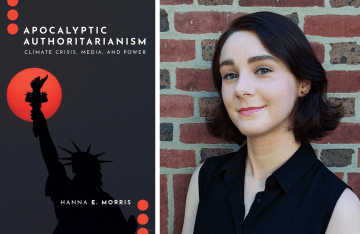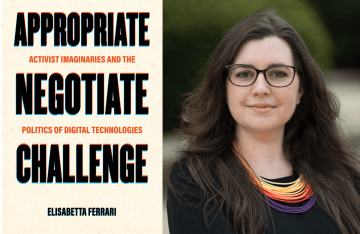Communication Major Alumna Q&A: Mika Rao (C’96), Managing Director, Regional Communications & Public Affairs at Teach For America
Rao discusses the differences and similarities between nonprofit and corporate communications, and how the field has changed.

Mika Rao
In celebration of the 40th anniversary of the Communication major at Penn, each Monday this semester we're running a series of Q&As with notable alumni. Last week we began the series with the Washington Post White House reporter — now White House Bureau Chief — Ashley Parker (C'05). The series continues below with Mika Rao (C'96).
Mika Rao (Kalapatapu), who graduated from Penn in 1996, is the Managing Director of Regional Communications & Public Affairs at Teach for America. Since graduating, she has worked in the healthcare, education, and finance sectors, contributed to numerous publications and been an active member of volunteer boards. In 2015, Rao joined Teach For America where she has oversight for the organization's strategic communications throughout Texas, Arkansas and Mississippi.
Update: Mika Rao left Teach for America in 2020 and is now a Principal at Rao Communications.
How did your experiences at Penn and the Annenberg School impact you in your career?
Penn has always been a place for people who make things happen. The spirit is contagious and my time on campus not only influenced my professional trajectory but ignited my personal convictions as well. As a communications major in the 1990s, I had the tremendous fortune of learning from thought leaders like [former] Dean Kathleen Hall Jamieson and Dr. Phyllis Kaniss. In Dr. Kaniss’ course, we observed the intersection of politics, race and advertising dollars and how these impact which stories get covered by the media. I saw her teachings come to life as a junior, while interning at a local talk show during the summer of the OJ Simpson trial. Dr. Kaniss was my advisor for that internship program and in my two decades as a media relations professional, I never forgot the mix of factors that influence what gets covered. Her book, Making Local News, is still on my bookshelf. Additionally, Dr. Jamieson’s work around gender forever changed my perspective as a female leader. We explored this notion of women leaders needing to be “tough and caring” during her packed Political Communications class (and the topic was further covered in her book Beyond the Double Bind). It’s been twenty years, but her lessons about the nuances required of women in high-profile roles have stayed with me.
Over your 20 years in PR, marketing, and communications, how have you seen the landscape change in terms of how companies and non-profits communicate with their constituents?
It’s amazing to reflect on how the information super highway has evolved since I graduated. We have seen communication shift from being centered largely around in-person opportunities or a cascading approach, to today where organizations own their own channels and can reach the end-user directly through a variety of strategies. Between the smart phone and social media, communicators have 24-7 access to our audiences. The digital space is a powerful tool for storytelling that can shape policy and mindsets.
How have you adapted to these changes?
It’s been an ongoing priority to know where my audience is spending time and speak to them in a way that resonates. For example, when I handled communications targeted to physicians — I recommended the healthcare system use a text messaging service as our platform, knowing that doctors were away from their desks but constantly on their smartphones. Today, when considering ways to reach college students, I’m not above asking the teens in my life for tips on Instagram and Snapchat! Ultimately, for the lifelong communicator — we fall in love with any space that allows us to share stories, inform, connect and engage — so adaptation is the name of the game!
You’ve done communications in both for-profit and non-profit sectors. How do you compare the two? What lessons from each apply to the other?
I think in both non-profit and for profit organizations, goals for communications remain similar. You have a strategic message and you need to meet people where they are. When I was the marketing manager for Dale Carnegie Training, it was important to generate awareness of our product among the corporate world (banner ads on websites were the cutting edge strategy in the late 1990s!). Just a few years later, I handled public affairs for a foundation committed to increasing the number of registered organ donors in South Georgia. I took the show on the road — often driving several hours to small churches and rotary club meetings in these rural communities, in order to spread the word about the need for donors. I think no matter where you work, as a communications professional your one job is to understand your audience and how to engage them.
At a time when funding for public education in America has been on the decline, Teach for America has an important role to play. What messages are you trying to get across about the organization? What are the best channels for doing that?
With the state of America today — such polarization and economic challenges — it’s more important than ever that driven and capable graduates join organizations committed to the long game of equity. Teach For America attracts talented individuals to make an initial two year commitment to lead classrooms. Twenty-seven years in, what’s clear and what’s inspiring is that the vast majority of our corps members end up making a lifelong commitment to tackling systemic inequity. Some remain in the classroom, some are school and system leaders, and others are social entrepreneurs, hold public office, or work to uplift low income communities in various ways. To that end, our messages focus on informing top prospects, donors and the public about the challenges students in high needs communities face and motivating visionaries and leaders to be part of the solution. We are finding that sharing messages across our digital ecosystem, which includes social media, websites, and email is critical. That said, we continue to raise awareness by pitching stories and op-eds to traditional media outlets as well.
What are the most rewarding aspects of your job at Teach for America?
The issues of poverty and inequity are so immense and it will take many of us working on it from all angles to turn the system around and create better outcomes for kids and communities. Although I’m not interacting with students in the classroom, as the managing director for regional communications and public affairs, I’m able to elevate the issues of kids in high needs communities and hopefully shine a light on challenges these bright minds face in overcoming systemic barriers. As a mother thinking of my own children and all of the access and privilege they are afforded, I am determined to bring greater equity and opportunity to all children. I’m humbled to play a small part in this movement through my role at TFA. It is tremendously fulfilling and the work I’ve always wanted to do.
What advice would you give to Communication majors hoping to go into corporate or non-profit communications?
At the risk of sounding like someone’s 8th grade English teacher, my big advice is to remember that the devil is in the details. The best practices of spell-check, editing and reviewing your work for clarity, and risk mitigation are evergreen. First jobs in the communications industry are not always glamorous but if you can master skills of excellence early in your career, you will distinguish yourself. Spend time now honing your skills as a writer and take advantage of the wonderful resources at the Annenberg School to improve as a strategic thinker. Outside of this, communications is so much more than what you say, but also what you do and how you make your audience feel. Strong communications professionals take the time to understand who they are speaking to. Whether I was designing messaging for pharmaceutical reps when I worked at Accenture, developing hand-hygiene posters targeted at health care providers as a hospital marketing director, or now — engaging more individuals to join the fight to end educational inequity — the first step remains the same: walk a mile in the shoes of the person you are trying to reach.



